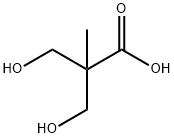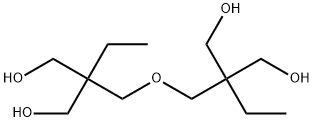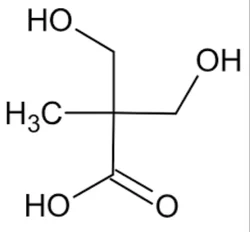2,2-Bis(hydroxymethyl)propionic acid
Synonym(s):2,2-Bis(hydroxymethyl)propionic acid;Bis-MPA;Dimethylolpropionic acid;DMPA
- CAS NO.:4767-03-7
- Empirical Formula: C5H10O4
- Molecular Weight: 134.13
- MDL number: MFCD00004199
- EINECS: 225-306-3
- SAFETY DATA SHEET (SDS)
- Update Date: 2025-09-11 17:37:59

What is 2,2-Bis(hydroxymethyl)propionic acid?
Chemical properties
white crystalline powder
The Uses of 2,2-Bis(hydroxymethyl)propionic acid
In preparation of water-sol alkyl resins.
The Uses of 2,2-Bis(hydroxymethyl)propionic acid
2,2-Bis(hydroxymethyl)propionic acid is commonly used as an AB2 monomer for the synthesis of hyperbranched (hb) polymers and dendrimers.
The Uses of 2,2-Bis(hydroxymethyl)propionic acid
2,2-bis(hydroxymethyl)propionic acid (DMPA) is a versatile organic materials. it is used as water-based polyurethane chain extender, also make the polyurethane obtained from emulsifying properties, excellent stability can be made self-emulsifying aqueous polyurethane. For preparation a photosensitive resin and liquid crystal materials; for epoxy ester coatings, polyurethane elastomers and powder coatings; Preparation of magnetic recording materials and adhesives etc..
What are the applications of Application
2,2-Bis(hydroxymethyl)propionic acid is A key raw material in polyurethane dispersion for coatings
Definition
ChEBI: 2,2-Bis(hydroxymethyl)propionic acid is a 3-hydroxy carboxylic acid.
Properties of 2,2-Bis(hydroxymethyl)propionic acid
| Melting point: | 189-191 °C(lit.) |
| Boiling point: | 167.23°C (rough estimate) |
| Density | 0.84 |
| vapor density | <1 (vs air) |
| refractive index | 1.4240 (estimate) |
| Flash point: | >150°C |
| storage temp. | Inert atmosphere,Room Temperature |
| solubility | H2O: soluble |
| form | Crystalline Powder |
| pka | 4.16±0.15(Predicted) |
| color | White |
| PH | 2.6 (50g/l, H2O, 20℃) |
| Water Solubility | soluble |
| Sensitive | Hygroscopic |
| Merck | 14,3253 |
| BRN | 1756385 |
| Stability: | Stable. Hygroscopic. |
| CAS DataBase Reference | 4767-03-7(CAS DataBase Reference) |
| NIST Chemistry Reference | 2,2-Bis(hydroxymethyl)propionic acid(4767-03-7) |
| EPA Substance Registry System | Dimethylolpropionic acid (4767-03-7) |
Safety information for 2,2-Bis(hydroxymethyl)propionic acid
| Signal word | Warning |
| Pictogram(s) |
 Exclamation Mark Irritant GHS07 |
| GHS Hazard Statements |
H319:Serious eye damage/eye irritation |
| Precautionary Statement Codes |
P305+P351+P338:IF IN EYES: Rinse cautiously with water for several minutes. Remove contact lenses, if present and easy to do. Continuerinsing. |
Computed Descriptors for 2,2-Bis(hydroxymethyl)propionic acid
| InChIKey | PTBDIHRZYDMNKB-UHFFFAOYSA-N |
2,2-Bis(hydroxymethyl)propionic acid manufacturer
Triveni Interchem Private Limited (Group Of Triveni Chemicals)
New Products
4,4-Difluoropiperidine hydrochloride tert-butyl 9-methoxy-3-azaspiro[5.5]undecane-3-carboxylate Indole Methyl Resin N-Isopropylurea N,N-Dicyclohexylcarbodiimide(DCC) MELDRUMS ACID 5-METHYLISOXAZOLE-4-CARBOXYLIC ACID Magnessium Bis glycinate Zinc ascorbate 1-bromo-2-butyne 2-acetamidophenol 9(10H)-anthracenone Erythrosin B, 4-Piperidinopiperidine 2-((4-morpholinophenylamino) (methylthio) methylene) malononitrile 2,4-dihydroxybenzaldehyde 3-(4-morpholinophenylamino)-5-amino-1H-pyrazole-4-carbonitrile Methyl 2-methylquinoline-6-carboxylate 2,6-dichloro-4-nitropyridine 4-Bromo-2-chlorobenzonitrile 2-(benzylamino)acetic acid hydrochloride 4-(tert-Butoxycarbonylamino)but- 2-ynoic acid 3,4-dihydro-2H-benzo[b][1,4]dioxepine 1-Phenyl-1-cycloprppanecarboxylicacidRelated products of tetrahydrofuran








You may like
-
 2,2-Bis(hydroxymethyl)propionic acid CAS 4767-03-7View Details
2,2-Bis(hydroxymethyl)propionic acid CAS 4767-03-7View Details
4767-03-7 -
 2,2-Bis(hydroxymethyl)propionic Acid CAS 4767-03-7View Details
2,2-Bis(hydroxymethyl)propionic Acid CAS 4767-03-7View Details
4767-03-7 -
 2,2-Bis(hydroxymethyl)propionic acid, 98% CAS 4767-03-7View Details
2,2-Bis(hydroxymethyl)propionic acid, 98% CAS 4767-03-7View Details
4767-03-7 -
 2,2-Bis(hydroxymethyl)propionic acid CAS 4767-03-7View Details
2,2-Bis(hydroxymethyl)propionic acid CAS 4767-03-7View Details
4767-03-7 -
 Dimethylolpropionic AcidView Details
Dimethylolpropionic AcidView Details
4767-03-7 -
 Solid Dimethylolpropionic Acid, 4767-03-7View Details
Solid Dimethylolpropionic Acid, 4767-03-7View Details
4767-03-7 -
 20677-73-0 (2,2-diethoxyethyl)methylamine 98%View Details
20677-73-0 (2,2-diethoxyethyl)methylamine 98%View Details
20677-73-0 -
 3-(4-(hydroxyamino)-1-oxoisoindolin-2-yl)piperidine-2,6-dione 98%View Details
3-(4-(hydroxyamino)-1-oxoisoindolin-2-yl)piperidine-2,6-dione 98%View Details
